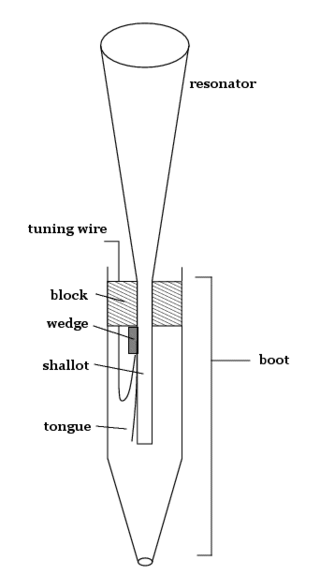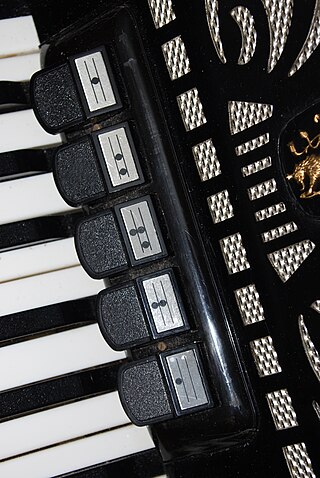
A brass instrument is a musical instrument that produces sound by sympathetic vibration of air in a tubular resonator in sympathy with the vibration of the player's lips. Brass instruments are also called labrosones or labrophones, from Latin and Greek elements meaning 'lip' and 'sound'.

The pipe organ is a musical instrument that produces sound by driving pressurised air through the organ pipes selected from a keyboard. Because each pipe produces a single pitch, the pipes are provided in sets called ranks, each of which has a common timbre, volume, and construction throughout the keyboard compass. Most organs have many ranks of pipes of differing pitch, timbre, and volume that the player can employ singly or in combination through the use of controls called stops.

In music, the organ is a keyboard instrument of one or more pipe divisions or other means for producing tones. The organs have usually two or three, up to five, manuals for playing with the hands and a pedalboard for playing with the feet. With the use of registers, several groups of pipes can be connected to one manual.

A combination tone is a psychoacoustic phenomenon of an additional tone or tones that are artificially perceived when two real tones are sounded at the same time. Their discovery is credited to the violinist Giuseppe Tartini and so they are also called Tartini tones.

An organ stop is a component of a pipe organ that admits pressurized air to a set of organ pipes. Its name comes from the fact that stops can be used selectively by the organist; each can be "on", or "off".
A mixture is an organ stop, usually of principal tone quality, that contains multiple ranks of pipes including at least one mutation stop. It is designed to be drawn with a combination of stops that forms a complete chorus, for example, principals of 8 foot, 4′, and 2′ pitches. The mixture emphasizes upper harmonics of each note of the keyboard; the individual pitches in the mixture are not distinguished by the listener, but reinforce the fundamental (lowest) pitch, adding volume, timbre (colour) and brilliance to the sound. Because pipes playing upper harmonics produce their own set of harmonic overtones, an element of harmonic dissonance is introduced, giving mixtures their characteristic tonal texture as they enrich the ensemble. Historically, the mixture descends from the medieval Blockwerk concept, an organ in which there were no stops and all the ranks sounded simultaneously.

A pedalboard is a keyboard played with the feet that is usually used to produce the low-pitched bass line of a piece of music. A pedalboard has long, narrow lever-style keys laid out in the same semitone scalar pattern as a manual keyboard, with longer keys for C, D, E, F, G, A, and B, and shorter, raised keys for C♯, D♯, F♯, G♯ and A♯. Training in pedal technique is part of standard organ pedagogy in church music and art music.

A theatre organ is a type of pipe organ developed to accompany silent films, from the 1900s to the 1920s.

A flue pipe is an organ pipe that produces sound through the vibration of air molecules, in the same manner as a recorder or a whistle, in a pipe organ. Air under pressure is driven through a flue and against a sharp lip called a labium, causing the column of air in the pipe to resonate at a frequency determined by the pipe length. Thus, there are no moving parts in a flue pipe. This is in contrast to reed pipes, whose sound is driven by beating reeds, as in a clarinet.

An organ pipe is a sound-producing element of the pipe organ that resonates at a specific pitch when pressurized air is driven through it. Each pipe is tuned to a note of the musical scale. A set of organ pipes of similar timbre comprising the complete scale is known as a rank; one or more ranks constitutes a stop.

A reed pipe is an organ pipe that is sounded by a vibrating brass strip known as a reed. Air under pressure is directed towards the reed, which vibrates at a specific pitch. This is in contrast to flue pipes, which contain no moving parts and produce sound solely through the vibration of air molecules. Reed pipes are common components of pipe organs.

The Boardwalk Hall Auditorium Organ, known also as the Midmer-Losh and the Poseidon, is the pipe organ in the Main Auditorium of the Boardwalk Hall in Atlantic City, New Jersey, built by the Midmer-Losh Organ Company. It is the largest organ in the world, as measured by the number of pipes.
Gedackt is the name of a family of stops in pipe organ building. They are one of the most common types of organ flue pipe. The name stems from the Middle High German word gedact, meaning "capped" or "covered".
A Tibia Clausa is a type of pipe organ pipe. It is a large-scale, stopped wood flute pipe, usually with a leathered lip. The rank was invented by Robert Hope-Jones. Tibia Clausas provides the basic foundation tone of the organ with few overtones or harmonics. The Tibia Clausa is arguably the most important rank of pipes in a theatre pipe organ, with some organs having as many as 5. The stop shares similarities with the Bourdon and the Gedackt found in some church pipe organs. In the 18th and 19th centuries, Tibia Clausa was sometimes used as an alternate name for Doppelflöte. Most tibias are made from wood, as by Wurlitzer etc., although examples of metal tibias may be found made by the John Compton Organ Company.

The pipe organ is played from an area called the console or keydesk, which holds the manuals (keyboards), pedals, and stop controls. In electric-action organs, the console is often movable. This allows for greater flexibility in placement of the console for various activities. Some very large organs, such as the van den Heuvel organ at the Church of St. Eustache in Paris, have more than one console, enabling the organ to be played from several locations depending on the nature of the performance.
Registration is the technique of choosing and combining the stops of a pipe organ in order to produce a particular sound. Registration can also refer to a particular combination of stops, which may be recalled through combination action. The registration chosen for a particular piece will be determined by a number of factors, including the composer's indications, the time and place in which the piece was composed, the organ the piece is played upon, and the acoustic environment within which the organ resides.
In music a voluntary is a piece of music, usually for an organ, that is played as part of a church service. In English-speaking countries, the music played before and after the service is often called a 'voluntary', whether or not it is so titled.

A reed rank inside an accordion is a single full set of the reeds that are the means to achieve the instrument's sound range. These reed ranks are located in the reed chamber. Most accordions to this date typically have between two and four reed ranks on the treble side and between three and five reed ranks on the bass side. These can usually be selected individually or combined in various ways to provide a range of different timbres, by use of register switches arranged by register from high to low. More of the top-line expensive accordions may contain five or six reed blocks on the treble side for different tunings, typically found in accordions that stress musette sounds.
On classical French organs, the plein jeu is a principal-based plenum registration. It includes the Montres, Bourdons, Prestants and Doublettes and the Fournitures and Cymbales. The classical French organ also allows for a reed-based registration; the grand jeu, which used a loud combination of reed stops in homophonic sections of larger pieces or standalone préludes.

St Peter and St Paul is a church in the town of Bromley, Borough of Bromley, in south east London. Known familiarly as Bromley Parish Church, it is not far from Bromley High Street and approximately halfway between Bromley North and Bromley South railway stations. The church is part of the Diocese of Rochester within the Church of England. Largely destroyed by bombing during the Second World War, St Peter and St Paul was rebuilt in the 1950s. It has been Grade II* listed since 1955.












